Related Research Articles

Santhal Pargana division constitutes six district administration units known as the divisions of Jharkhand state in eastern India.
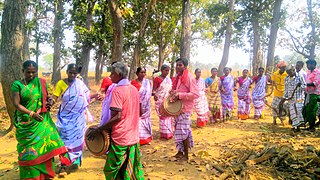
The Santal are an Austroasiatic-speaking Munda ethnic group of the Indian subcontinent. Santals are the largest tribe in the Jharkhand and West Bengal in terms of population and are also found in the states of Odisha, Bihar, Assam and Tripura. They are the largest ethnic minority in northern Bangladesh's Rajshahi Division and Rangpur Division. They have a sizeable population in Nepal. The Santals speak Santali, the most widely spoken Munda languages of Austroasiatic language family.

The Adivasi are heterogeneous tribal groups across the Indian subcontinent. The term is a Sanskrit word coined in the 1930s by political activists to give the tribal people an indigenous identity by claiming an indigenous origin. The Constitution of India does not use the word Adivasi, instead referring to Scheduled Tribes and Janjati. The government of India does not officially recognise tribes as indigenous people. The country ratified the International Labour Organization (ILO) Convention 107 on Indigenous and Tribal Peoples of the United Nations (1957) and refused to sign the ILO Convention 169. Most of these groups are included in the Scheduled Tribe category under constitutional provisions in India.
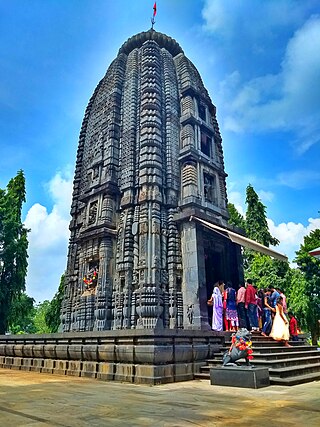
Mayurbhanj district is one of the 30 districts in the Odisha state of eastern India. It holds the distinction of being the largest district in Odisha by area. The district's headquarters is located in Baripada, with other major towns including Rairangpur, Karanjia, and Bahalda. As of 2011, Mayurbhanj ranks as the third-most populous district in Odisha, following Ganjam and Cuttack.

The Munda people are an Austroasiatic-speaking ethnic group of the Indian subcontinent. They speak Mundari as their native language, which belongs to the Munda subgroup of Austroasiatic languages. The Munda are found mainly concentrated in the south and East Chhotanagpur Plateau region of Jharkhand, Odisha and West Bengal. The Munda also reside in adjacent areas of Madhya Pradesh as well as in portions of Bangladesh, Nepal, and the state of Tripura. They are one of India's largest scheduled tribes. Munda people in Tripura are also known as Mura. In the Kolhan region of Jharkhand the Munda people are often called Tamadia by other communities.
The tribes of Jharkhand consist of 32 scheduled tribes inhabiting the Jharkhand state in India. In 1872, only 18 tribes were counted among the scheduled tribes from which Banjara, Bhatudi, Chik Baraik, and Mahli were marked as semi-Hindu aboriginal and Kora as proletariat Hindu. In the 1931 census, including the above four semi-Hindu aboriginal and Kora, a proletariat Hindu, the number was raised to 26 from 18. They were Birajia, Godait, Karmali and Paharia, but Kisan was excluded from the list. In the 1941 census, Baga, Bedia and Lohra were included again taking Kisan in the annexure and the number came to 30 which prevailed till June 2003. Kanwar and Kol were added on 8 June 2003 in the annexure and the number of Schedule Tribes came to 32.
The Kol people referred to a group of tribal communities of Chotanagpur in eastern parts of India. Historically, the Mundas, Oraons, Ho and Bhumijs were called Kols by the British.
The Tea-garden community is a term for a multiethnic, multicultural group of tea garden workers and their descendants in Assam. They are officially referred to as Tea-tribes by the government of Assam and notified as Other Backward Classes (OBC). They are the descendants of peoples from multiple tribal and caste groups brought by the British colonial planters as indentured labourers from the regions of present-day Jharkhand, Odisha, Chhattisgarh, West Bengal and Andhra Pradesh into colonial Assam during the 1860-90s in multiple phases to work in tea gardens. They are found mainly in those districts of Upper Assam and Northern Brahmaputra belt where there is a high concentration of tea gardens, like Kokrajhar, Udalguri, Sonitpur, Biswanath, Nagaon, Golaghat, Jorhat, Sivasagar, Charaideo, Dibrugarh, Tinsukia, and Lakhimpur. There is a sizeable population of the community in the Barak Valley region of Assam as well in the districts of Cachar, Karimganj and Hailakandi. The total population is estimated to be around 7 million, of which an estimated 4.5 million reside in residential quarters built inside 799 tea estates spread across tea-growing regions of Assam. Another 2.5 million reside in the nearby villages spread across those tea-growing regions. They speak multiple languages, including Sora, Odia, Assam Sadri, Sambalpuri, Kurmali, Santali, Kurukh, Kharia, Kui, Chhattisgarhi, Gondi and Mundari. Assam Sadri, distinguished from the Sadri language, serves as lingua franca among the community.

Roughly 8.6 per cent of India's population is made up of "Scheduled Tribes" (STs), traditional tribal communities. In India those who are not Christians, Muslims, Jews, Sikhs, Buddhists, or Zoroastrians are identified as Hindus. The reason being varied beliefs and practices allowed in Hindusim and according of Hindusim as a geographical identity than merely Religious ones. Though, many of the Scheduled Tribes have modes of worship not typical to mainstream Hindusim but ontologically form part of the cultural practices of the land, as Nature or ancestral worship, with varying degrees of syncretism.
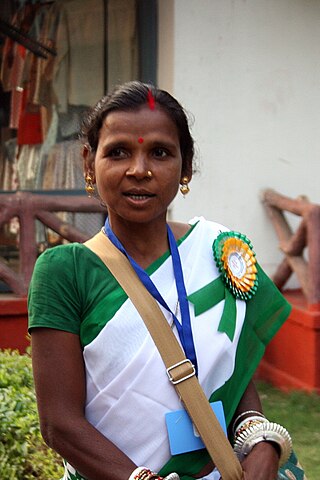
The Ho people are an Austroasiatic Munda ethnic group of India. They are mostly concentrated in the Kolhan region of Jharkhand and northern Odisha where they constitute around 10.7% and 7.3% of the total Scheduled Tribe population respectively, as of 2011. With a population of approximately 700,000 in the state in 2001, the Ho are the fourth most numerous Scheduled tribe in Jharkhand after the Santals, Kurukhs, and Mundas. Ho also inhabit adjacent areas in the neighbouring states of Odisha, West Bengal and Bihar bringing the total to 806,921 as of 2001. They also live in Bangladesh and Nepal.
Bhumij is a Munda ethnic group of India. They primarily live in the Indian states of West Bengal, Odisha, Assam and Jharkhand, mostly in the old Singhbhum district and also in states like Bihar and Assam. There is also a sizeable population found in Bangladesh. Bhumijas speak the Bhumij language, an Austroasiatic language, and use Ol Onal script for writing.
Below is given a chronological record of tribal and peasant revolts in India before independence from British rule in the 1947. The list covers those tribal uprisings that occurred during the period of British rule in India.

Sarnaism is a religious faith of the Indian subcontinent, predominantly followed by indigenous communities in the Chota Nagpur Plateau region across states like Jharkhand, Odisha, West Bengal, Bihar, and Chhattisgarh.

Baha parab or Baa parab is a spring festival of Ho, Santhal,Munda and other tribes in India. "Baha" or "Baa" means flower. At Baha parab or Baa parab men, women and children are attired in traditional clothes, Offering Flowers to God Marang Buru and Jaher Ayo, and Madal tamak(drums) are beat and tribal woman and man dancing.
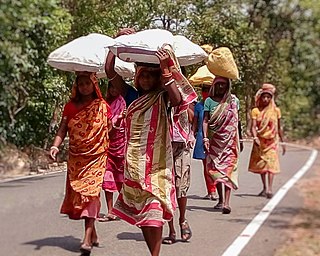
Bagal is a cattle herding caste of East India. Bagal people are living in the state of West Bengal, Jharkhand and Odisha. They use Kudmali/ Manbhumi dialect of Bengali as their mother tongue and use Bengali, Hindi and Odia language to communicate with the outside society.

Sarhul is a spring festival in the Indian state of Jharkhand. It is a symbol of commencement of the new year. The festival is celebrated for three days, from the 3rd day of Chaitra month in Sukla Paksh to Chaitra Purnima. In the festival, the village priest Pahan offers sacrifice of flowers, fruit, vermilion, rooster and tapan (liquor) in Sarna to Sun, village deity and ancestor for good fortune of the village. Then the locals dance holding flowers of the sal tree. According to the tradition, it also symbolises marriage between the Earth and the Sun. It is an important festival observed by the Kurukh and Sadan. Among Kurukh it is known as Khaddi in Kurukh.

Sari Dharam is the religion of the Santal people residing in India. Sari Dharam is one of the religious belief in eastern region of Indian states like Jharkhand, West Bengal, Bihar, Odisha and Assam. However, Santals also practices Sarnaism.
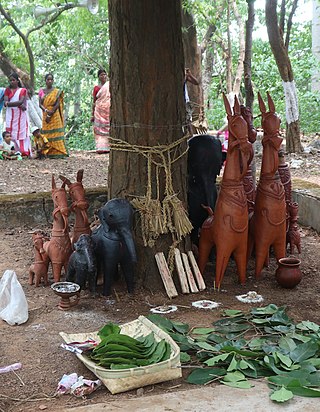
Jaherthan, Jahirathan or Jahergarh is a sacred grove worshiping place of Santal, Bhumij, Paharia and Bedia tribes present in India and Bangladesh. It is a characteristic feature of a Bhumij and Santal village on the edge of the village where many holy spirits live and where a series of annual festivals take place. This sacred grove is set aside in the founding of the village and left undisturbed except at times of festivals. Inside is set a series of natural (uncut) stones which represent the Bongas, but are not substitutes except during festival.
The Santal or Santhal, are a Munda ethnic group native to South Asia mostly in India, Bangladesh, Nepal and Bhutan. The Santal people speak Santali language is the most widely spoken tribal languages.
References
- ↑ Jha, Makhan (1998). India and Nepal: Sacred Centres and Anthropological Researches. M.D. Publications Pvt. Ltd. ISBN 978-81-7533-081-8.
- ↑ Sengupta, Saptarshi (2019). "Origins and the Early Settlements of the Santhals Through the Writings of Christian Missionaries and Others". Proceedings of the Indian History Congress. 80: 733–741. ISSN 2249-1937. JSTOR 27192927.
- ↑ "Chapter I Introduction Santhal as People" (PDF).
- ↑ "Origin and History of the Santal Ethnic Group of Nepal" (PDF).
- ↑ "Novelty Journals: High quality scientific journal publisher" (PDF).
- ↑ Kochar, V. K. (1966). "Village Deities of the Santal and Associated Rituals". Anthropos. 61 (1/2): 241–257. ISSN 0257-9774. JSTOR 40458237.
- ↑ Hembram, Mayamani; Tripathy, Dr Sishir Kumar (May 2020). "The Religious Beliefs and Practices of Santal Tribe in Mayurbhanj District of Odisha: Role of Santal Women". International Journal of Psychosocial Rehabilitation. 24 (5): 9085–9102. ISSN 1475-7192.
- ↑ MPost (2023-02-08). "'State's decision to recognise Sari, Sarna as separate religions likely to deal a blow to BJP'". www.millenniumpost.in. Retrieved 2024-05-31.
- ↑ Survey Report on Village Rangamatia, Mayurbhanj District. Controller of Publications. 1988.
- ↑ Behera, Maguni Charan (2024-09-03). The Routledge Handbook of Tribe and Religions in India: Contemporary Readings on Spirituality, Belief and Identity. Taylor & Francis. ISBN 978-1-040-11433-9.
- ↑ Karam Binti
- ↑ Jomsim Binti
- ↑ Karam Binti
- ↑ Karam Binti